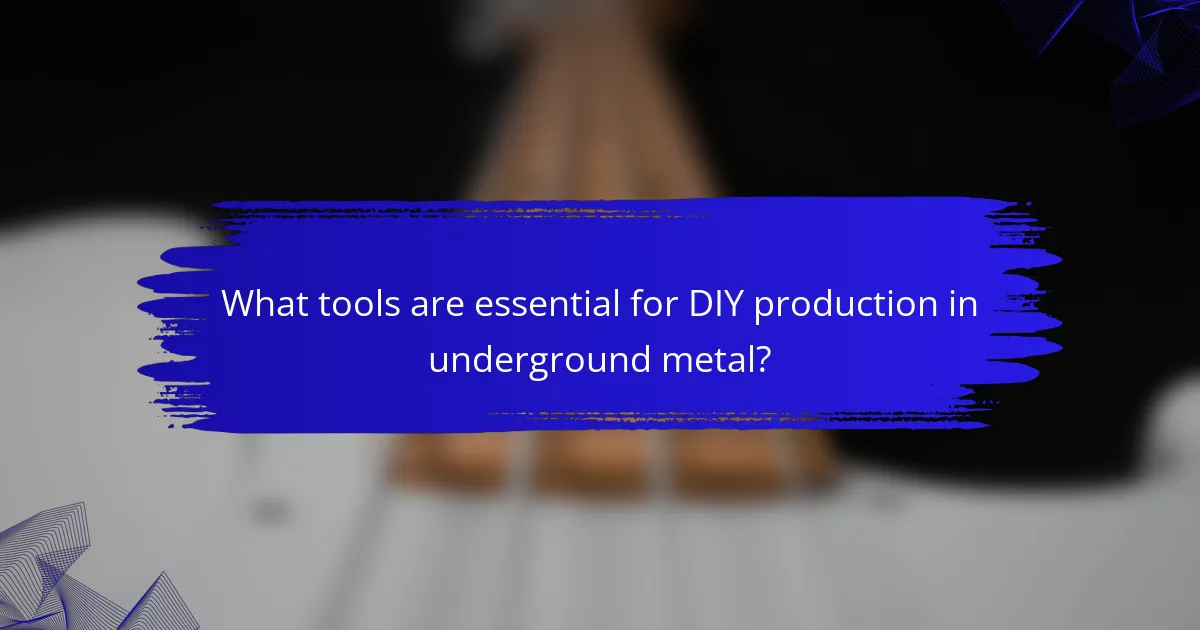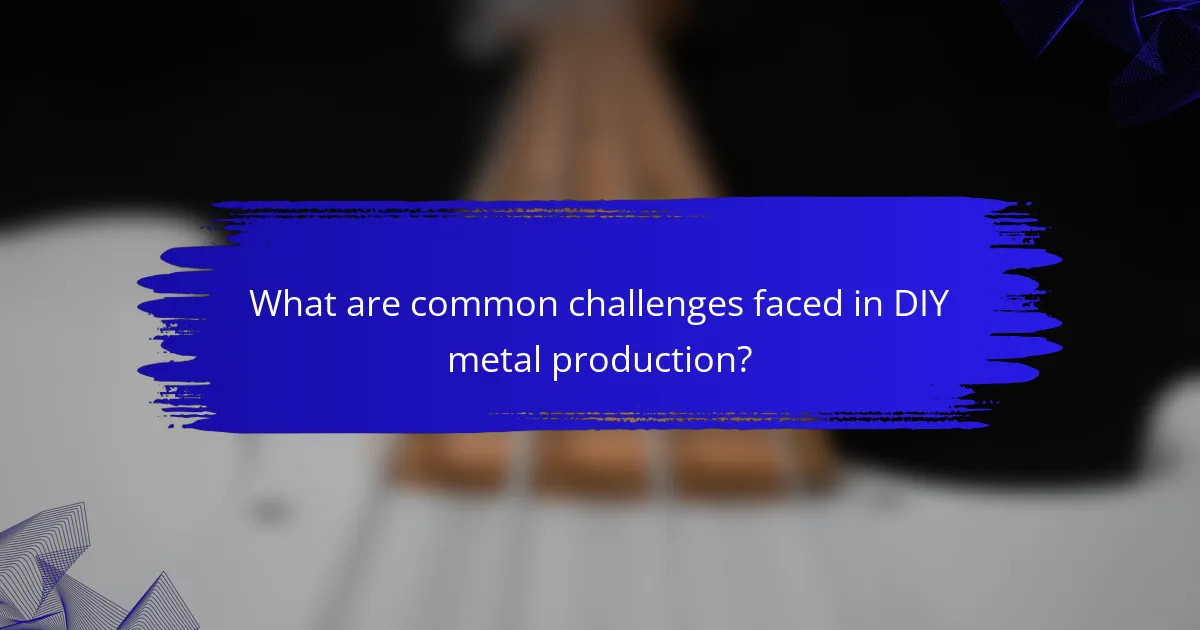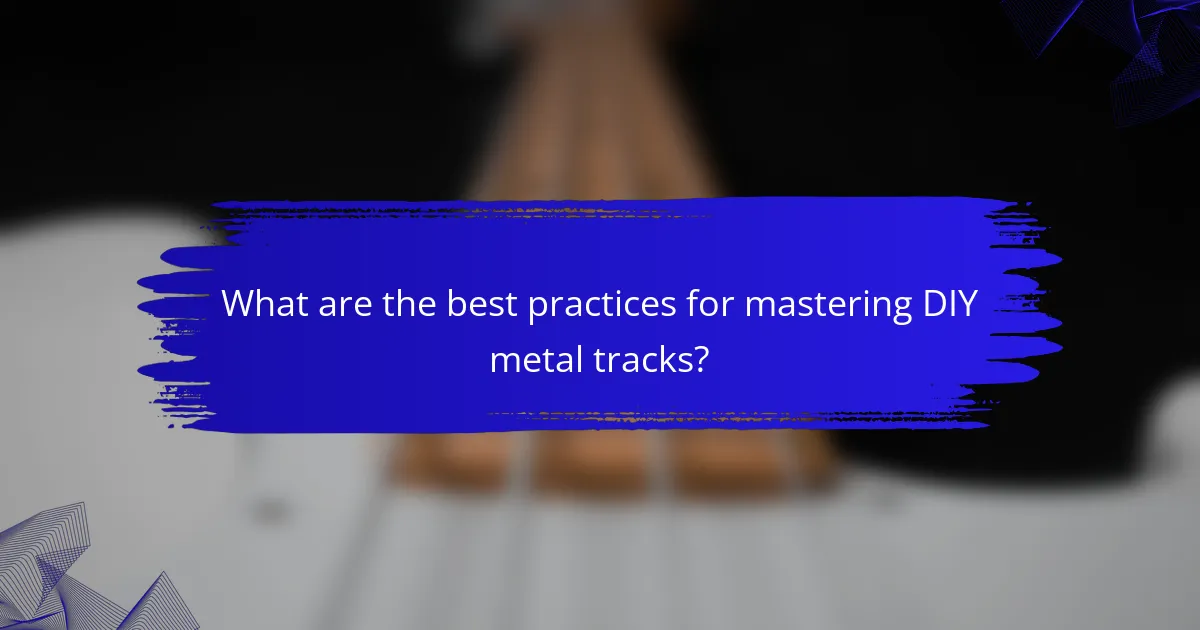DIY production techniques in underground metal empower musicians to create high-quality sound on a budget. Essential tools include audio interfaces, DAWs, and microphones. Key strategies involve leveraging affordable software, experimenting with home recording, and collaborating with local artists. Overcoming common challenges like equipment costs and technical skills can enhance creativity and foster community within the genre.

What tools are essential for DIY production in underground metal?
Essential tools for DIY production in underground metal include a quality audio interface, digital audio workstation (DAW), microphones, headphones, and instrument amplifiers. These tools enable musicians to record, mix, and produce high-quality sound. A versatile audio interface allows for multiple inputs and outputs, while a DAW provides the software environment for editing and arranging tracks. Quality microphones capture vocals and instruments accurately, and good headphones ensure precise monitoring during mixing. Instrument amplifiers enhance the sound of electric guitars and basses, crucial for achieving the desired metal tone.
How do different recording interfaces affect sound quality?
Different recording interfaces significantly impact sound quality by influencing signal clarity, dynamic range, and frequency response. High-quality interfaces typically offer better analog-to-digital conversion, resulting in more accurate recordings. Features such as preamp quality and bit depth also play crucial roles in overall sound fidelity. For example, a 24-bit interface captures a wider dynamic range compared to a 16-bit one, enhancing the detail in recordings. Additionally, interfaces with higher sample rates can reproduce audio more accurately, particularly in the high-frequency range.
Which microphones are best for capturing heavy metal vocals?
Dynamic microphones are best for capturing heavy metal vocals due to their durability and ability to handle high sound pressure levels. Models like the Shure SM58 and the Sennheiser e835 excel in this genre. They provide clarity in the mid-range frequencies, which is essential for aggressive vocal styles. Additionally, condenser microphones like the Audio-Technica AT2020 can capture the nuances of vocal performances, making them suitable for studio settings. A combination of both types can deliver a balanced sound for heavy metal recordings.
What role does software play in DIY music production?
Software is essential in DIY music production, enabling artists to create, edit, and mix tracks efficiently. It provides tools for recording, arranging, and mastering music, which are vital in underground metal genres. Digital Audio Workstations (DAWs) like Ableton Live and Reaper offer features tailored for metal, such as multi-track recording and effects processing. Additionally, plugins enhance sound quality and allow for unique sonic experimentation, helping artists achieve their vision. Overall, software empowers musicians to produce professional-quality music from home.

How can musicians create a professional sound on a budget?
Musicians can create a professional sound on a budget by utilizing DIY production techniques. Focus on essential tools like affordable audio interfaces, quality microphones, and digital audio workstations (DAWs).
1. Leverage free or low-cost software for mixing and mastering.
2. Experiment with home recording techniques to optimize acoustics.
3. Use online resources for tutorials on sound design and production.
4. Collaborate with local musicians for shared resources and knowledge.
These strategies help maintain high production quality without significant financial investment.
What are the most cost-effective recording techniques?
DIY recording techniques in underground metal can be cost-effective when using simple tools and methods. Focus on home recording setups that utilize software like Audacity or GarageBand, which are free or low-cost.
Utilize dynamic microphones for vocals and instruments, as they are affordable and durable. Incorporate techniques such as multi-tracking to layer sounds effectively without expensive equipment.
Experiment with DIY acoustic treatments using materials like foam or blankets to control sound quality. Lastly, leverage online resources and communities for tips and collaboration to enhance production skills without financial strain.
Which free or low-cost software options are available for mixing?
Free or low-cost software options for mixing include Audacity, GarageBand, Cakewalk, and Tracktion T7. These tools offer essential features for DIY production in underground metal.
Audacity provides multi-track editing and effects. GarageBand is user-friendly for Mac users, featuring virtual instruments. Cakewalk offers professional-grade capabilities for Windows users, including advanced mixing options. Tracktion T7 is a versatile DAW with unlimited audio and MIDI tracks, suitable for various genres.

What techniques can enhance the mixing process for underground metal?
To enhance the mixing process for underground metal, use techniques like layered tracking, dynamic range adjustment, and creative EQ. Layered tracking involves recording multiple takes to achieve a fuller sound. Dynamic range adjustment ensures clarity by balancing loud and soft elements. Creative EQ allows for unique tonal shaping, enhancing the overall mix.
How does layering instruments improve overall sound?
Layering instruments enhances overall sound by creating depth and complexity. This technique allows for a richer sonic texture, as different instruments contribute unique tonal qualities. For instance, combining rhythm guitars with melodic leads adds dimension, making the mix more engaging. Additionally, varying the arrangement of layers can emphasize certain frequencies, improving clarity and impact. Ultimately, effective layering can transform a simple track into a dynamic composition that resonates with listeners.
What are effective EQ techniques for heavy guitar riffs?
Effective EQ techniques for heavy guitar riffs include layering, dynamic range control, and frequency carving. Layering involves recording multiple guitar tracks to create a fuller sound. Dynamic range control ensures that the riffs maintain clarity and punch, often achieved through compression. Frequency carving helps eliminate muddiness by adjusting EQ settings to highlight essential frequencies, typically around 80-120 Hz for warmth and 3-5 kHz for presence. These techniques enhance the overall impact of heavy guitar riffs in underground metal production.
Which compression settings work best for drums in metal music?
For drums in metal music, use a fast attack and medium release compression setting. This enhances punch while maintaining dynamics. Aim for a ratio of 4:1 to 6:1 and adjust the threshold to catch peaks without squashing the sound. A makeup gain of 3-5 dB can help maintain overall level.

How can DIY producers achieve a unique sound signature?
DIY producers can achieve a unique sound signature by experimenting with unconventional techniques and tools. Utilizing effects like distortion, reverb, and delay creatively can shape the overall tone. Layering different instruments and sounds creates depth and complexity. Incorporating field recordings or found sounds adds originality. Adjusting mic placements and using various recording environments can enhance texture. Finally, embracing imperfections and unique production methods fosters an authentic sonic identity.
What unconventional recording techniques can be utilized?
Unconventional recording techniques can enhance DIY production in underground metal. Techniques such as using field recordings to capture ambient sounds, layering unconventional instruments like found objects, and employing reverse reverb can create unique textures. Additionally, utilizing smartphone apps for effects processing and experimenting with unconventional mic placements can yield interesting results. These methods allow for creativity and individuality in sound production, setting your work apart.
How does experimenting with effects shape the final mix?
Experimenting with effects significantly shapes the final mix by enhancing depth and texture. This process allows producers to manipulate sound, creating unique auditory experiences. Different effects, such as reverb and distortion, can alter the emotional impact of a track, making it resonate more with listeners. By exploring various combinations, producers can discover innovative soundscapes that define the underground metal genre. This experimentation fosters creativity, enabling artists to push boundaries and develop a distinct sonic identity.

What are common challenges faced in DIY metal production?
Common challenges in DIY metal production include safety hazards, equipment cost, material sourcing, and technical skill requirements. Safety is paramount, as improper handling of tools can lead to injuries. The cost of high-quality tools can be prohibitive for hobbyists. Sourcing suitable metal can be difficult, especially for specific alloys. Additionally, mastering techniques like welding or casting requires time and practice, which can deter newcomers.
How can sound isolation be achieved in a home studio?
Sound isolation in a home studio can be achieved through strategic design and material choices. Use heavy curtains, acoustic panels, and rugs to absorb sound. Seal windows and doors with weather stripping to minimize noise leakage. Consider building a soundproof booth for recording vocals or instruments. Additionally, using isolation pads for speakers can reduce vibrations.
What are the pitfalls of self-mixing and how to avoid them?
Self-mixing can lead to inconsistent sound quality, poor balance, and lack of professional polish. To avoid these pitfalls, ensure you have the right tools, such as quality headphones and a reliable digital audio workstation. Familiarize yourself with mixing techniques and take breaks to maintain perspective. Regularly reference professional mixes for comparison and adjust your approach accordingly.

How can collaboration enhance DIY projects in the underground metal scene?
Collaboration enhances DIY projects in the underground metal scene by fostering creativity and resource sharing. Working together allows musicians, producers, and fans to exchange skills, tools, and ideas, leading to innovative sound production.
Collaborative efforts can result in unique projects that combine diverse influences, enriching the overall quality of music. Additionally, pooling resources can lower production costs, making high-quality DIY projects more accessible.
Networking through collaboration also strengthens community ties, promoting a supportive environment essential for the growth of underground metal. As a result, artists can gain exposure and develop their craft more effectively within a collaborative framework.
What platforms facilitate collaboration among musicians?
Several platforms facilitate collaboration among musicians, enhancing DIY production in underground metal. Notable options include Soundtrap, BandLab, and Splice. These platforms offer tools for real-time collaboration, cloud storage, and access to a vast library of sounds. They support various formats of intake, such as audio files and MIDI, allowing musicians to work together seamlessly regardless of location. Additionally, platforms like Discord and Facebook Groups provide spaces for networking and sharing tips, fostering a community around underground metal production techniques.
How can feedback from peers improve production quality?
Feedback from peers can significantly enhance production quality by providing diverse perspectives. Constructive criticism helps identify weaknesses in sound, arrangement, and performance. Engaging with fellow musicians fosters collaboration, leading to innovative ideas and improved techniques. This exchange of insights often results in a more polished final product, as peer input can refine mixing and mastering processes. Ultimately, a supportive feedback loop elevates the overall standard of DIY productions in underground metal.

What are the best practices for mastering DIY metal tracks?
To master DIY metal tracks, focus on quality recording equipment, software proficiency, and sound design techniques. Use a good audio interface, dynamic microphones, and DAWs like Reaper or Pro Tools. Layer guitar tracks for depth and apply EQ and compression for clarity. Experiment with reverb and delay to enhance atmosphere. Regularly reference professional mixes to refine your sound.
How does mastering differ from mixing in the production process?
Mastering focuses on finalizing audio tracks for distribution, while mixing blends individual elements within a track. Mastering enhances overall sound quality and ensures consistency across playback systems. Mixing involves adjusting levels, panning, and effects to create a cohesive sound. Each process requires specific tools and techniques, with mastering often utilizing specialized software for frequency correction and loudness optimization. Understanding these distinctions is crucial for effective DIY production in underground metal.
What tools are recommended for DIY mastering?
For DIY mastering, recommended tools include a digital audio workstation (DAW), audio interface, studio monitors, and mastering plugins. These essential tools enable effective sound balancing, dynamic control, and overall audio enhancement.
1. Digital Audio Workstation (DAW) – Provides a platform for mixing and editing tracks.
2. Audio Interface – Ensures high-quality audio input and output.
3. Studio Monitors – Offer accurate sound reproduction for better mixing decisions.
4. Mastering Plugins – Enhance audio quality with tools for equalization, compression, and limiting.
Which common mistakes should be avoided during mastering?
To master DIY production techniques in underground metal, avoid common mistakes like neglecting room acoustics, using low-quality equipment, and skipping the mixing process. Prioritize proper mic placement and learn to use your tools effectively.
1. Ignoring acoustics can lead to poor sound quality.
2. Using subpar equipment limits your production potential.
3. Skipping mixing results in an unbalanced final product.
4. Poor mic placement can distort sound capture.
5. Not experimenting with techniques stunts creativity.
What tips can help achieve a polished final product?
To achieve a polished final product in DIY underground metal production, focus on precision and attention to detail. Start with high-quality tools, such as a reliable audio interface and studio monitors, to ensure accurate sound reproduction. Use proper microphone placement to capture the best audio quality. Experiment with mixing techniques to enhance the overall sound while maintaining clarity. Regularly reference professional tracks to gauge your mix’s quality and make necessary adjustments. Finally, invest time in mastering your tracks to ensure they are well-balanced and polished for distribution.